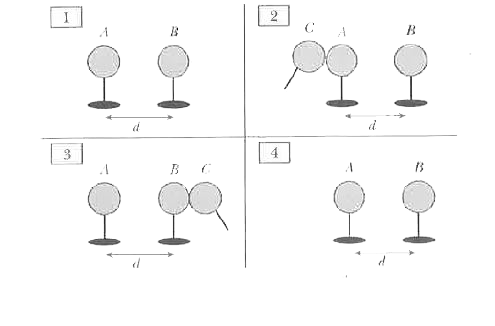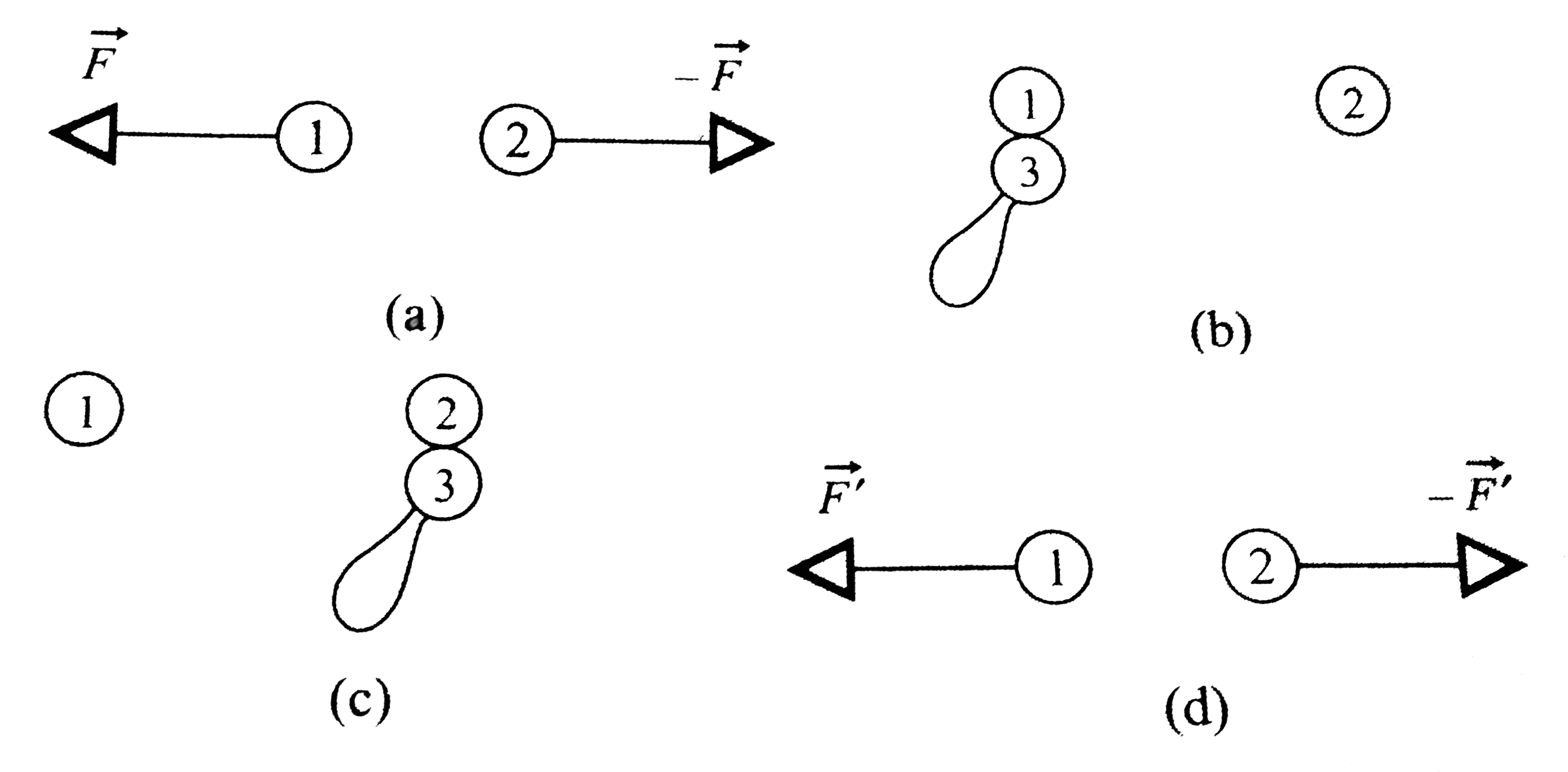Two identical conducting spheres A and B carry charges Q and 2Q respectively. They are separated by a distance much larger than their diameters. A third identical conducting sphere C is uncharged. Sphere C is first touched to A then to B and finally removed. As a result the electrostatic force between A and B which was originally F becomes:
The initial force between the two charges separated by a distance d is F = 2kQ2/d2 . After touching the charges become Q/2 and 5Q/4 and the force is 5kQ2/8d2 = 5F/16 .
Related Solutions
Two identical conducting spheres A and B, carry equal charge. They are separated by a distance much larger than their diameters, and the force between them is F. A third identical conducting spheres, C,is uncharged. Sphere C is first touched to A, then to B, and then removed. As a result, the force between A and B would be equal to :
View SolutionTwo identical conducting spheres A and B, carry equal charge. They are separated by a distance much larger than their diameters, and the force between them is F. A third identical conducting spheres, C,is uncharged. Sphere C is first touched to A, then to B, and then removed. As a result, the force between A and B would be equal to :
View SolutionA and B are two identical point sized metal spheres each holding the same charge .q.. These two are separated by certain distance and the mutual electrostatic force between them is F. If a third identical uncharged sphere .C. is touched with A and kept exactly at the midpoint of line joining A and B, what is the resulting force on C and its direction?
View SolutionA and B are two identical point sized metal spheres each holding the same charge q . These two are separated by certain distance and the mutual electrostatic force between them is F. if a third identical uncharged sphere 'C' is touched with A and kept exactly at the midpoint of line joining A and B, what is the resulting force on C and its direction ?
View SolutionTwo identical conducting spheres are charged by induction and then separated by a large distance, sphere 1 has charge +Q and sphere 2 has charge -Q. A third sphere is initially uncharged. If sphere 3 is touched to sphere 1 and separated and then touched to sphere 2 and separated what is the final charge on each of the three spheres?
View SolutionIn Frame 1, two identical conducting spheres, A and B, carry equal amounts of excess charge that have the same sign. The spheres are separated by a distance d, and sphere A exerts an electrostatic force on sphere B that has a magnitude F. A third sphere, C, Which is handled only by an insulating rod, is introduced in Frame 2. Sphere C is identical to A and B except that it initially uncharged. Sphere C is touched first to sphere A, in Frame 2, and then to sphere B, in Frame 3, and is finally removed in Frame 4.

Determine the magnitude of the electrostatic force that sphere A exerts on sphere B in Frame 4.View SolutionConsider three identical metal spheres and C. Spheres A carres charge carries no charge . Spheres A and B are touchd together and them separated. Sphere C is then touched to sphere and separated from it . Finally the sphere is touched to sphere and separated from it . Find the final chage on the sphere .
View SolutionTwo identical conducting spheres are charged by induction and then sepatatd by a large distance, sphere-1 has charge +Q and spher-2 has charge -Q. A third sphere is initially uncharged. If sphere-3 is touched to sphere-1 and sepatated and then touched to sphere-2 and separated what is the final charge on each of the three spheres?
View SolutionTwo identical metallic sphere's A and B having charges are kept a certain distance apart. A third identical uncharged sphere C is first placed in contact with sphere A and then with sphere B. Spheres A and B are then brought in contact and then separated. Find the charges on the spheres A and B.
View SolutionTwo insulated charged copper spheres A and.B of identical size have charges and respectively. A third sphere C of the same size but uncharged is brought in contact with the first and then in contact with the second and finally removed from both. What are the new charges on A and B?
View SolutionTwo identical metallic spherical shells A and B having charges + 4 Q and -10Q are kept a certain distance apart. A third identical uncharged sphere C is first placed in contact with sphere A and then with sphere B, then spheres A and B are brought in contact and then separated. Find the charge on the spheres A and B.
View SolutionConsider three identical metal spheres A, B and C . Sphere A carries charge + 6q , sphere B carries charge -3q and sphere C carries no charge . Spheres A and B are touched together and then separated. Sphere C is then touched to sphere A and separated from it . Finally the sphere C is touched to sphere B and separated from it . Find the final charge on the sphere C .
View SolutionThere are two charged identical metal spheres A and B repel each other with a force . Another identical uncharged sphere C is touched with A and then placed at the mid-point between A and B. Net force on C is
View SolutionTwo identical conducting spheres 1 and 2 carry equal amounts of charge and are ficed apart at a certain distance larger than their diameters. The spheres repel each other with an electrical force of 88mN. A thired identical sphere 3, having an insulating handle and initially uncharged, is touched first to sphere 1 and then to sphere 2 and finally removed. Find the force between spheres 1 and 2 as shown if Figure.
 ,View Solution
,View SolutionTwo identical conducting spheres 1 and 2 carry equal amounts of charge and are ficed apart at a certain distance larger than their diameters. The spheres repel each other with an electrical force of 88mN. A thired identical sphere 3, having an insulating handle and initially uncharged, is touched first to sphere 1 and then to sphere 2 and finally removed. Find the force between spheres 1 and 2 as shown if Figure. ,
View SolutionIndentical isolated conduction sphers 1 and 2 have equal charges and are separated by a distance that is large compared with their diameters (Fig.a). The electrostatic force acting on spkhere 2 due to sphere 1 is F. Suppose now that a third identical sphere 3, having an insulation handle and initially neutral, is touched first to sphere 1 (Fig. b), then to sphere 2 (Fig. c), and dinally removed (Fig. d). The electrostatic force that now acts on sphere 2 has magnitude F'. What is the (F')/(F) ?
View SolutionIndentical isolated conduction sphers 1 and 2 have equal charges and are separated by a distance that is large compared with their diameters (Fig.a). The electrostatic force acting on spkhere 2 due to sphere 1 is F. Suppose now that a third identical sphere 3, having an insulation handle and initially neutral, is touched first to sphere 1 (Fig. b), then to sphere 2 (Fig. c), and dinally removed (Fig. d). The electrostatic force that now acts on sphere 2 has magnitude F'. What is the (F')/(F) ?
View SolutionTwo equally charged, identical metal spheres A and B rpepel each other with a force F. the spheres are kept fixed with a distance r between them. A third identical, but uncharged sphere C is brought in contact with A and then placed at the mid-point of thr line joining A and B. the magnitude of the net electric force on C is
View SolutionTwo equally charged, identical metal spheres A and B repel each other with a force F. The sphere are kept fixed with a distance r between them. A third identical, But uncharged sphere C is brought in contact with A and then placed at the mid-point of the line joining A and B. The magnitude of the net electric force on C is :
View Solution
